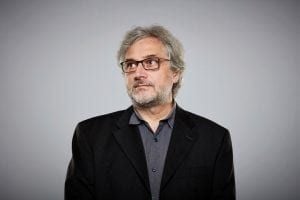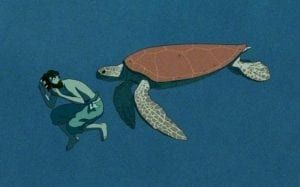By Linda Marric
Considered by many as one of the most talented animators working in Europe at the moment, Michael Dudok de Wit hit the jackpot when he was approached out of the blue by Studio Ghibli to make a film with them. The result was one of the best received films at last year’s Cannes Film Festival and went on to win praise as well as prizes around the world. The Red Turtle came out of nowhere to steal the hearts of all those who saw it and fell in love with it instantly.
Last week I had the great pleasure of meeting De Wit for a short interview in which I asked him about the process he went through during the making the film and his relationship with the producers at Ghibli in Tokyo.
How did your association with Studio Ghibli come about? Who contacted whom, and did they tell you exactly what they wanted from you?
I wouldn’t have dared contacting them saying “can I propose something to work on with you”. They did, and they did so quite bluntly via email. It literally said, we want to produce your next feature if you’re thinking of making one, and we would like to co-produce it with Wild Bunch in Paris. Just like that. They didn’t even say “let’s meet for a meal and talk things through”. My question was just like yours, you want me to come to Tokyo and work there or do you have a story you want me to translate? But they said no, you make it in Europe, this is an experiment for us, you propose a story and a visual style and let’s take it step by step.

I’m no Ghibli expert having only seen a handful of their films, it seems to me that this isn’t the usual Ghibli style. Was that a deliberate attempt on your part to make it look more personal?
It was never my ambition to emulate Japanese animation…and to make sure of it, I asked them if they wanted me to make a film that looks like a Ghibli film, and they said no…. they said you do something that you feel comfortable with. But we have things in common, they make films that are in general very much directors films, they’re personal films yet accessible to an audience. And some of their films are incredibly successful. That would be the ideal feature for me, something that really comes from a very personal point but totally accessible to an audience, not a blockbuster necessarily, but something that works with an audience.
How did it feel for to go from making short animations to working on a larger scale on a feature? Was that more complicated?
Oh much more complicated, definitely……my worry was, will I lose passion for this project after a couple of years, because it’s relentless…..on the whole, I worked on it for 9 years, now that’s demanding a lot. Luckily, I didn’t lose passion, on the contrary, because the collaborators, especially the animators and background artists were even better than I’d hoped…..so on a daily basis, I would get new scenes in and I’d think “oh my god this is just fantastic”. Obviously, It was more complex, I’m an animator, so I’m used to sitting at my desk in the morning and animating all day along. When you’re a director you’re dissipated big time, you have to divert your attention to a lot of different things, administrative and creative. Also you get an avalanche of questions from your team and that was very challenging.
I found your story-telling and direction very realistic, can you tell us a bit about the themes you were keen to convey in the story?
My first choice was the visual style, design of characters, and the animation, I thought movements should be more realistic than the average animation film. They should not be cartoony. Why? I just thought that would make the film beautiful? Because animation is famous for crazy magic creatures, and everything is possible and that’s great and it works beautifully in some Studio Ghibli films, but often it also falls flat because you are overwhelmed by magic and you know that nothing dangerous can happen because everyone can survive something dangerous all the time, which I wanted to avoid. So for a long time in the film, everything that happens could happen in real life, then suddenly there’s one magic element.
I was very impressed and surprised by your choice of not giving your characters speech or more precisely a language. Was that because you wanted the film to feel more universal?
Yes more universal, but also slightly more surreal and more symbolic….because as soon as you add a voice you get some very personal things that you don’t need to know. Not only nationality, but also sensitivity, education, maturity. There are a lots of subtle massages, so I thought voices would be too much in this story, especially with the woman….I even imagined the woman would be quiet, and I had always imagined that she wouldn’t talk anyway. Initially I had the dialogue for the man and son, and that worked intellectually, because it would explain some things very nicely, but it wouldn’t work feeling wise….it just felt bizarre. There were temporary voices and not only me, but other people would say, it’s a bit bizarre when they start talking.

If I were to ask you what was the main theme of the film, what would you say it was?
No one has ever asked that question actually, people usually say what did you try to say about the film, but never the main theme…..[LAUGHS]
Really? I’m really sorry [laughs]
Ok….I have to mention two things, I can’t reduce it to just one. One of them is my deep love for nature, and I don’t mean just great plants and beautiful sunsets, but I also mean the rain and the night and the shape of shadows…and the wind….I mean nature in all its aspects, including the dangerous side of nature. That is so beautiful, I see that a lot in other films. The Japanese have cultural sensitivity to nature too. Ideally I wanted the viewer who sees the film to feel his or her own love for nature is stimulated by that. The other thing is the feeling of timelessness, by which I mean it’s not like “ok now finished, this is it”, it’s more like I wanted something eternal about the story, not because we don’t know what century it’s happening in, but because it’s about cycle and continuation, things get born and things die etc…
The film was nominated for best animation at this year’s Academy Awards, were you disappointed not to win?
No, and I don’t say that out of modesty, I mean Zootopia was by far the best candidate, and sometimes there’s a surprise and the surprise would have been Kubo And The Two Strings. They’re very well made basically, and they speak in an American way to an American public and of course the people who vote are mostly Americans. Also, historically in the last 10 years, relentlessly, computer animated films with dialogue and a moralising story, tend to win year after year.
Do you think there should be another category for hand-drawn animations like yours?
I don’t think so, because I don’t like to categorise films anymore than they already are. Ultimately, I like hand-drawing, that’s my field and that’s Studio Ghibli too because there’s something less glib about it, but if the story is beautiful, it doesn’t really matter what technique is used.
Were you happier to be nominated for a Cesar (French Academy award) because you work in France?
To be honest the Cannes Film Festival is the festival that I admire the most, it’s rare that they choose an animation to be screened at all, so to be selected for an animated film is already a huge compliment. Much more than other awards.
Finally, are you working on anything special at the moment?
No, I’m not ready yet because I’ve been more than full-time in promotion. So far, almost a year because it came out in Cannes lat year, and now we’re reaching the end. I’ve done some illustrating jobs for Japan over this year, and I think I need a long break and think about what’s next. One thing is certain, if I don’t have a story I love passionately, I shouldn’t make a film. Because you may run out of passion for the project if you don’t love the story deeply and that’s not nice. If you have a five year project and you lose interest after a year, that affects everything.
The Red Turtle is in cinemas from Friday 26th May.

